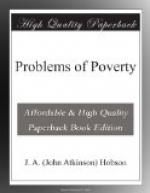For the purpose we have immediately before us, the measurement of poverty, the figures supplied in this book are invaluable. Considerations of space will compel us to confine our attention to such figures as will serve to mark the extent and meaning of city poverty in London. But though, as will be seen, the industrial causes of London poverty are in some respects peculiar, there is every reason to believe that the extent and nature of poverty does not widely differ in all large centres of population.
The area which Mr. Booth places under microscopic observation covers Shoreditch, Bethnal Green, Whitechapel, St. George’s in the East, Stepney, Mile End, Old Town, Poplar, Hackney, and comprises a population 891,539. Of these no less than 316,000, or 35 per cent, belong to families whose weekly earnings amount to less than 21s. This 35 per cent, compose the “poor,” according to the estimate of Mr. Booth, and it will be worth while to note the social elements which constitute this class. The “poor” are divided into four classes or strata, marked A, B, C, D. At the bottom comes A, a body of some 11,000, or 11/4 per cent, of hopeless, helpless city savages, who can only be said by courtesy to belong to the “working-classes” “Their life is the life of savages, with vicissitudes of extreme hardship and occasional excess. Their food is of the coarsest description, and their only luxury is drink. It is not easy to say how they live; the living is picked up, and what is got is frequently shared; when they cannot find 3d. for their night’s lodging, unless favourably known to the deputy, they are turned out at night into the street, to return to the common kitchen in the morning. From these come the battered figures who slouch through the streets, and play the beggar or the bully, or help to foul the record of the unemployed; these are the worst class of corner-men, who hang round the doors of public-houses, the young men who spring forward on any chance to earn a copper, the ready materials for disorder when occasion serves. They render no useful service; they create no wealth; more often they destroy it."[3]
Next comes B, a thicker stratum of some 100,000, or 111/2 per cent., largely composed of shiftless, broken-down men, widows, deserted women, and their families, dependent upon casual earnings, less than 18s. per week, and most of them incapable of regular, effective work. Most of the social wreckage of city life is deposited in this stratum, which presents the problem of poverty in its most perplexed and darkest form. For this class hangs as a burden on the shoulders of the more capable classes which stand just above it. Mr. Booth writes of it—




